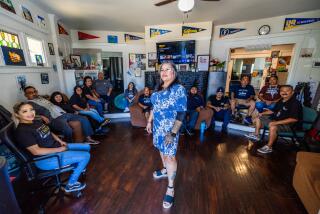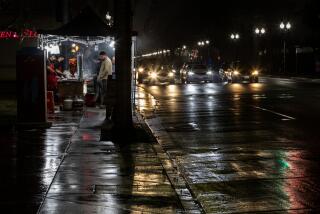Injunction Just One Tool Needed to Overhaul Orion
- Share via
The daily nightmare of life along Orion Avenue in North Hills--where dope dealers openly peddle their venom and frightened residents hide behind security gates--grew over long and complicated years of disinvestment and neglect. So while Los Angeles City Councilman Richard Alarcon’s suggestion that the neighborhood might benefit from a powerful gang injunction deserves scrutiny, such a measure would have negligible long-term effect if it were the only solution imposed on a community where problems defy easy answers.
Although Alarcon’s proposal is still in the early stages, injunctions have become relatively popular tools for police to fight the kind of entrenched criminality that hard-core gang members bring to the neighborhoods they occupy. Injunctions work by giving police the power to arrest certain gang members for actions that otherwise would be legal. For instance, gang members identified in an injunction might be prohibited from loitering at certain intersections at certain hours or they might even be prevented from wearing pagers.
In 1993, a similar injunction was issued against members of a gang along Blythe Street in Panorama City, then considered among the worst neighborhoods in Los Angeles. Police credited it with reducing crime in the neighborhood, but civil libertarians dispute that the injunctions have much effect at all and argue that they come at too high a price to personal freedoms. When used properly, though, an injunction can be a powerful and effective tool to rout thugs. But on Orion Avenue, an injunction would be only the first step--a good way to clean the slate before addressing the systemic problems that lure young men and women to crime as a vocation in the first place.
On Orion Avenue, that means city agencies other than the Police Department need to get involved as well. For instance, inspectors from the city’s Housing Department and Building and Safety Department must vigorously enforce housing and safety standards to prevent apartments from slipping into disrepair. Few things drag neighborhoods down faster than derelict buildings, which quickly turn into the hide-outs of vagrants and the playgrounds of hoodlums. At the same time, the city should invest in infrastructure to keep roads smooth and street lights working.
Physical improvements only go so far, though. Schools should work with police to identify children at risk of falling prey to the gangs so they can get the attention they deserve. Young people need to be shown that the math, the grammar, the biology they learn in school can pay off with an honest career. That requires coordination between schools and businesses.
Finally--and perhaps most importantly--residents themselves need to take control of their neighborhood and their children. Many are immigrants whose transition to life in Los Angeles has been less than smooth. They grapple with children whose values and language differ from their own. Yes, it is a challenge. But the stakes are too high to ignore.
The very need for a widespread gang injunction is a sign that the young people of Orion Avenue were failed somewhere along the way. By their schools, by their friends, by their parents, by themselves. But the streets can be swept clean of thuggery only so many times. Alarcon’s injunction proposal makes sense, but only as a single piece of a coordinated effort by the city, the schools, the churches, the social service agencies and the residents. Otherwise, an injunction runs the risk of doing little but clearing the streets for the next generation of outlaws.
More to Read
Sign up for Essential California
The most important California stories and recommendations in your inbox every morning.
You may occasionally receive promotional content from the Los Angeles Times.










